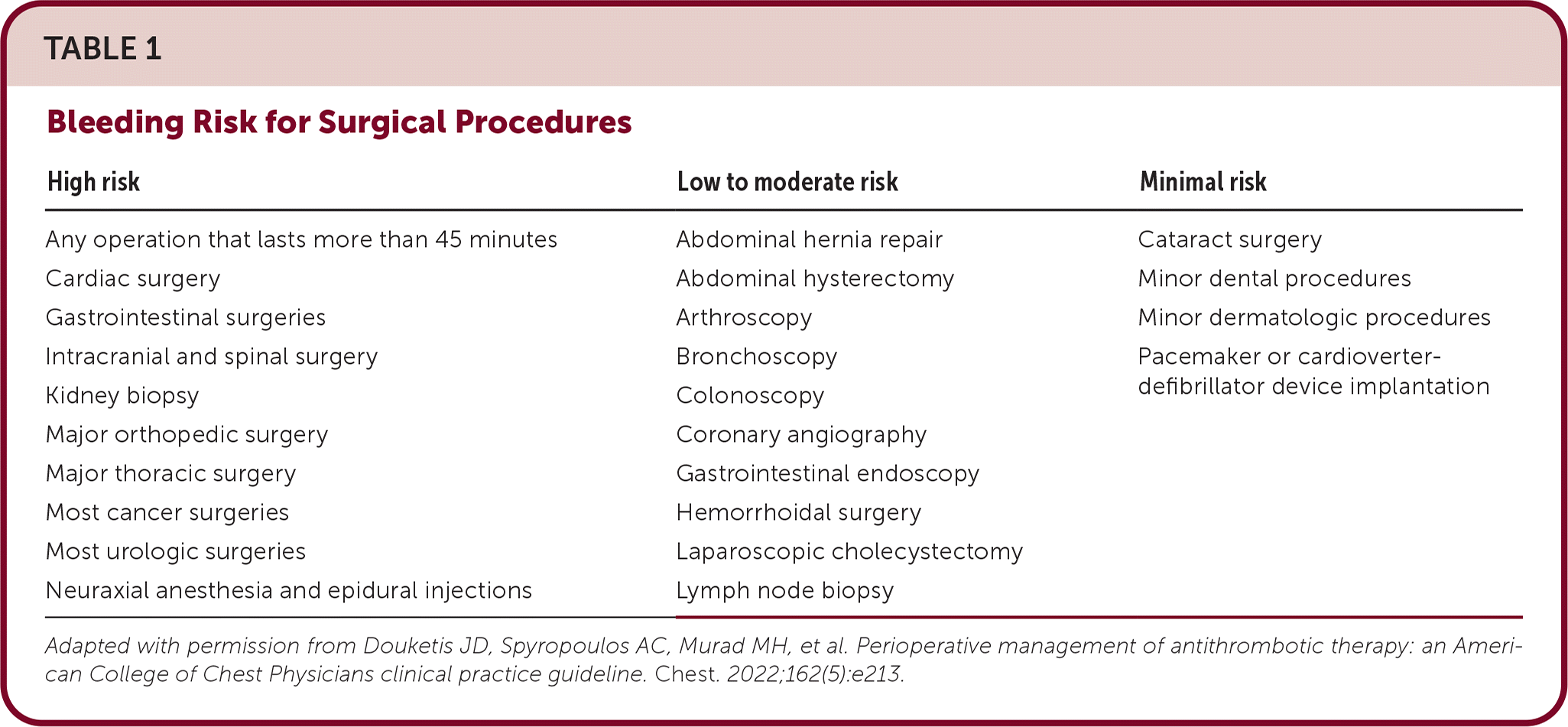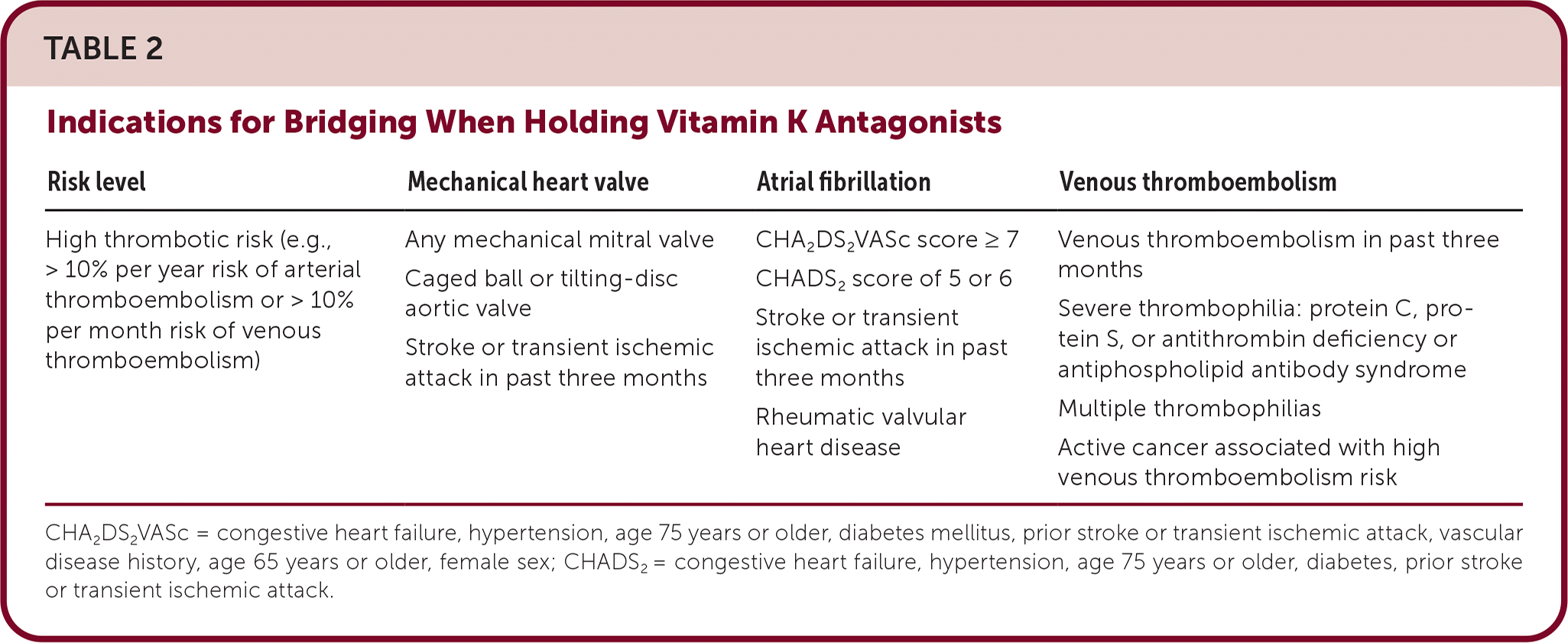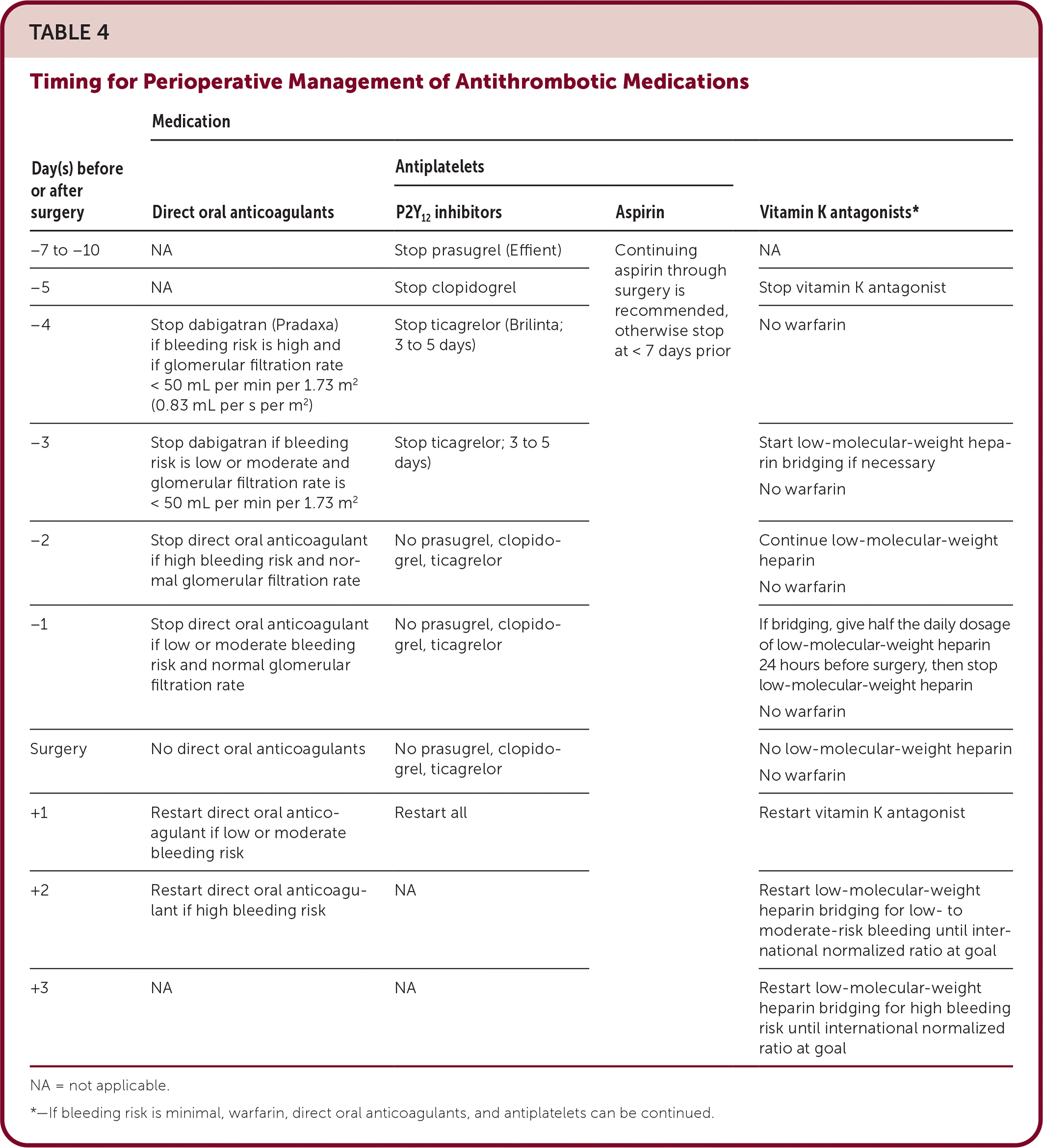
Am Fam Physician. 2023;108(2):208-211
Author disclosure: No relevant financial relationships.
Key Points for Practice
• Perioperative antithrombotic management depends on balancing bleeding risk with risk for thrombosis; for surgeries with minimal bleeding risk, continue antithrombotic treatment.
• Because of their rapid onset and degradation, most direct oral anticoagulants can be stopped one to two days before a procedure and restarted one to two days after the procedure in patients without significant chronic kidney disease.
• Bridging with heparin for patients taking warfarin is reserved for those at high risk of thromboembolism in most cases.
• Aspirin can be continued through most surgeries.
From the AFP Editors
Up to 20% of patients taking antithrombotic medications will need an invasive procedure. The American College of Chest Physicians published updated guidelines on perioperative management of antithrombotic medications for elective procedures based on a systematic review of primarily low-quality evidence.
Balance of Risks
The risk of bleeding following a procedure and the risk of thromboembolism from the initial need for antithrombotic treatment are the two factors used to determine whether and how long to hold medications. Table 1 stratifies common surgeries by bleeding risk. For procedures with minimal bleeding risk, the antithrombotic medication can generally be continued. For low- to moderate- or high-bleeding risk, most medications are stopped before surgery and later restarted. Patient or surgical factors may increase bleeding risk.

| High risk | Low to moderate risk | Minimal risk |
|---|---|---|
| Any operation that lasts more than 45 minutes | Abdominal hernia repair | Cataract surgery |
| Cardiac surgery | Abdominal hysterectomy | Minor dental procedures |
| Gastrointestinal surgeries | Arthroscopy | Minor dermatologic procedures |
| Intracranial and spinal surgery | Bronchoscopy | Pacemaker or cardioverter-defibrillator device implantation |
| Kidney biopsy | Colonoscopy | |
| Major orthopedic surgery | Coronary angiography | |
| Major thoracic surgery | Gastrointestinal endoscopy | |
| Most cancer surgeries | Hemorrhoidal surgery | |
| Most urologic surgeries | Laparoscopic cholecystectomy | |
| Neuraxial anesthesia and epidural injections | Lymph node biopsy |
Knowing the risk for thrombosis is important if medications are held, especially when antithrombotic medications are held for longer periods of time. Because direct oral anticoagulants are held for a short period of time, bridging with heparin is generally not recommended. The American College of Chest Physicians suggests heparin bridging for high thrombotic risk conditions if the patient is taking a vitamin K antagonist (Table 2).

| Risk level | Mechanical heart valve | Atrial fibrillation | Venous thromboembolism |
|---|---|---|---|
| High thrombotic risk (e.g., > 10% per year risk of arterial thromboembolism or > 10% per month risk of venous thromboembolism) | Any mechanical mitral valve Caged ball or tilting-disc aortic valve Stroke or transient ischemic attack in past three months | CHA2DS2VASc score ≥ 7 CHADS2 score of 5 or 6 Stroke or transient ischemic attack in past three months Rheumatic valvular heart disease | Venous thromboembolism in past three months Severe thrombophilia: protein C, protein S, or antithrombin deficiency or antiphospholipid antibody syndrome Multiple thrombophilias Active cancer associated with high venous thromboembolism risk |
Management of Direct Oral Anticoagulant Medications
For procedures with minimal bleeding risk, direct oral anticoagulants can be continued. Because of their rapid onset and degradation, most direct oral anticoagulants can be stopped one to two days before a procedure and restarted one to two days after the procedure in patients without significant chronic kidney disease. If bleeding risk is higher than minimal (i.e., low to moderate or high) and glomerular filtration rate is 50 mL per min per 1.73 m2 (0.83 mL per s per m2) or greater, stop all direct oral anticoagulants one to two days before surgery (Table 3 and Table 4). When the glomerular filtration rate is less than 50 mL per min per 1.73 m2, stop dabigatran (Pradaxa) four days before surgery for high bleeding risk and three days before surgery for low to moderate bleeding risk.

| Bleeding risk | Direct oral anticoagulant | Vitamin K antagonist | Antiplatelet |
|---|---|---|---|
| High | Hold for 48 hours before surgery Hold dabigatran (Pradaxa) for four days if glomerular filtration rate < 50 mL per min per 1.73 m2 (0.83 mL per s per m2) Consider increasing hold time for severely impaired renal function, impaired hepatic function, or if taking medications that inhibit CYP 3A4 | Hold for five days before surgery Bridge with heparin if thrombotic risk is high | Hold clopidogrel for five days before surgery Hold ticagrelor (Brilinta) for three to five days before surgery Hold prasugrel (Effient) for seven to 10 days before surgery Continuing aspirin is recommended; hold for seven days or less if holding |
| Low to moderate | Hold for 24 hours before surgery Hold dabigatran for three days if glomerular filtration rate < 50 mL per min per 1.73 m2 Consider increasing hold time for severely impaired renal function, impaired hepatic function, or if taking medications that inhibit CYP 3A4 | Hold for five days before surgery Bridge with heparin if thrombotic risk is high | |
| Minimal | Continue medication | Continue medication | Continue medication |

| Day(s) before or after surgery | Medication | |||
|---|---|---|---|---|
| Direct oral anticoagulants | Antiplatelets | Vitamin K antagonists* | ||
| P2Y12 inhibitors | Aspirin | |||
| −7 to −10 | NA | Stop prasugrel (Effient) | Continuing aspirin through surgery is recommended, otherwise stop at < 7 days prior | NA |
| −5 | NA | Stop clopidogrel | Stop vitamin K antagonist | |
| −4 | Stop dabigatran (Pradaxa) if bleeding risk is high and if glomerular filtration rate < 50 mL per min per 1.73 m2 (0.83 mL per s per m2) | Stop ticagrelor (Brilinta; 3 to 5 days) | No warfarin | |
| −3 | Stop dabigatran if bleeding risk is low or moderate and glomerular filtration rate is < 50 mL per min per 1.73 m2 | Stop ticagrelor; 3 to 5 days) | Start low-molecular-weight heparin bridging if necessary No warfarin | |
| −2 | Stop direct oral anticoagulant if high bleeding risk and normal glomerular filtration rate | No prasugrel, clopidogrel, ticagrelor | Continue low-molecular-weight heparin No warfarin | |
| −1 | Stop direct oral anticoagulant if low or moderate bleeding risk and normal glomerular filtration rate | No prasugrel, clopidogrel, ticagrelor | If bridging, give half the daily dosage of low-molecular-weight heparin 24 hours before surgery, then stop low-molecular-weight heparin No warfarin | |
| Surgery | No direct oral anticoagulants | No prasugrel, clopidogrel, ticagrelor | No low-molecular-weight heparin No warfarin | |
| +1 | Restart direct oral anticoagulant if low or moderate bleeding risk | Restart all | Restart vitamin K antagonist | |
| +2 | Restart direct oral anticoagulant if high bleeding risk | NA | Restart low-molecular-weight heparin bridging for low- to moderate-risk bleeding until international normalized ratio at goal | |
| +3 | NA | NA | Restart low-molecular-weight heparin bridging for high bleeding risk until international normalized ratio at goal | |
Direct oral anticoagulants can be restarted 24 hours after surgery unless the surgical bleeding risk is high. For a surgery with high bleeding risk, delay restarting the medication for 48 to 72 hours. Because direct oral anticoagulants have a rapid onset, excessive bleeding may occur if they are started too early. After surgery, the bleeding risk must again be balanced against the thrombosis risk. If anticoagulation is delayed, low-molecular-weight heparin for venous thromboembolism prophylaxis after surgery is still recommended.
Management of Vitamin K Antagonist Medications
For patients taking the vitamin K antagonist warfarin, continue the medication if bleeding risk is minimal. With low to moderate or high bleeding risk, stop warfarin; patients with high thrombosis risk should receive heparin before and after surgery. In patients who are at low to moderate risk for thromboembolism, no bridging with heparin is recommended. For atrial fibrillation, the benefits of bridging are less certain because the stroke risk over a few days is low.
Warfarin should be stopped at least five days before the procedure and restarted 12 to 24 hours after the procedure if hemostasis has been obtained (Table 4).
Heparin bridging can occur with unfractionated heparin or low-molecular-weight heparin. If intravenous unfractionated heparin is used, heparin should be stopped at least four hours before the procedure and restarted at least 24 hours after the procedure. If low-molecular-weight heparin is used, give one-half the daily dosage 24 hours before the procedure, and wait at least 24 hours after surgery to give the first postoperative dose of low-molecular-weight heparin. If the surgery has a high bleeding risk, wait 48 to 72 hours before restarting heparin to ensure hemostasis.
Management of Antiplatelet Medications
Continuing aspirin is recommended for all noncardiac surgery. If stopping aspirin, the American College of Chest Physicians recommends stopping within seven days of surgery.
P2Y12 platelet receptor inhibitors should be stopped before surgery (Table 3 and Table 4). Stop clopidogrel five days before surgery, ticagrelor (Brilinta) three to five days before surgery, and prasugrel (Effient) seven to 10 days before surgery. All P2Y12 inhibitors can be restarted within 24 hours of surgery if hemostasis has been obtained.
For dual-antiplatelet therapy post stent placement, management depends on the time since stent placement. If the patient is within 12 weeks postcoronary stenting, either delaying elective surgery or continuing both medications is recommended because of the high risk of stent thrombosis. For patients who are more than three months after coronary stent placement, the recommendation is to stop the P2Y12 inhibitor and continue aspirin therapy. Bridging these gaps with antiplatelet or anticoagulant medications does not improve outcomes.

| Score | Criteria |
|---|---|
| Yes | Focus on patient-oriented outcomes |
| Yes | Clear and actionable recommendations |
| Yes | Relevant patient populations and conditions |
| Yes | Based on systematic review |
| Yes | Evidence graded by quality |
| Yes | Separate evidence review or analyst in guideline team |
| Cannot tell | Chair and majority free of conflicts of interest (both chairs report significant conflicts of interest but recusal from the pharmaceutical companies as of 2021; both recused from voting) |
| Cannot tell | Development group includes most relevant specialties, patients, and payers (mix of specialties, apparently no patient input) |
| Overall – useful |
Editor's Note: This is the first update to these guidelines for management of antithrombotic medications since 2012, when direct oral anticoagulants were very new. Direct oral anticoagulants are now the recommended anticoagulant medication for most patients, and their management is relatively simple because of their short onset and rapid degradation. Because these medications can be held one to two days before surgery and restarted one to two days after surgery, bridging with heparin is not recommended, unlike with warfarin. The other interesting recommendation is to continue aspirin through the surgery because of little, if any, increase in bleeding.—Michael J. Arnold, MD, Assistant Medical Editor
Guideline source: American College of Chest Physicians
Published source: Chest. November 2022;162(5):e207–e243.
